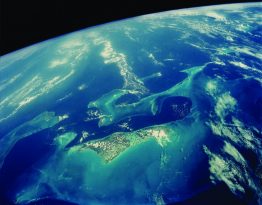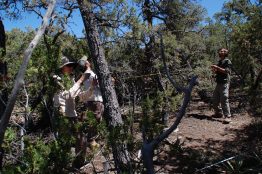Two University of Washington undergraduates from the College of the Environment recently received Outstanding Student Paper Awards from the American Geophysical Union as a result of their presentation at the annual fall meeting held in December 2016. Eliza Dawson, a senior in the Department of Atmospheric Sciences, won based on her presentation titled “Variability of the Inter-Tropical Convergence Zone Related to Changes in the Inter-Hemispheric Dust Load.”
Read more »Listen to the Earth smash another global temperature record
Federal science agencies announced Wednesday that 2016 was the warmest year on record, beating the previous global temperature record set in 2015, which itself had beat the previous record set in 2014. Now atmospheric scientists at the University of Washington have set the new temperature record to an electronic dance beat. This is their second project to convert scientific data to an audio track, a process known as sonification.
Read more at UW Today »Large forest die-offs can have effects that ricochet to distant ecosystems
Major forest die-offs due to drought, heat and beetle infestations or deforestation could have consequences far beyond the local landscape. Wiping out an entire forest can have significant effects on global climate patterns and alter vegetation on the other side of the world, according to a study led by the University of Washington and published Nov. 16 in PLOS ONE. “When trees die in one place, it can be good or bad for plants elsewhere, because it causes changes in one place that can ricochet to shift climate in another place,” said lead author Elizabeth Garcia, a UW postdoctoral researcher in atmospheric sciences.
Read more at UW Today »CO2 record at Mauna Loa, the music video: The sounds of climate change
The UW Department of Atmospheric Sciences‘ Judy Twedt, a doctoral student, and Dargan Frierson, an associate professor, recently put the world’s longest-running measure of atmospheric carbon dioxide to music. The result is a 90-second rendition of human-induced climate change:
Read more at UW Today »UW scientist helping direct NASA field study of clouds off Namibia
Tiny aerosol particles, emitted by everything from tailpipes to trees, float above us reflecting sunlight, seeding clouds and absorbing solar heat. How exactly this happens — and how it might change in the future — is one of the biggest uncertainties in how humans are influencing climate. University of Washington scientists are part of a NASA field campaign, Observations of Aerosols Above Clouds and their Interactions, or ORACLES, that is flying research planes around clouds off the coast of Namibia to see how smoke and clouds interact.
Read more at UW Today »




